[Publisher’s note: Welcome to Bike Law 101, a new column written for BikePortland by Kurt Jansen. Kurt is the Executive Director of the Animated Traffic Law Center. ATLC is a Eugene, Oregon based non-profit that helps organizations with their traffic law education efforts (the City of Portland hired them to create the “Every Corner is a Crosswalk” animation). Each month, Kurt will tackle a tricky bike law with hopes of adding some clarity to a our vehicle code.]
Entering an intersection on a solid yellow light is illegal in Oregon unless you cannot stop in time safely.
It’s a familiar enough scene. You’re on your bike approaching an intersection and the light is green. But, it’s been green for a while now; any second it will go to yellow (or perhaps it already has). Signal engineers call this the “dilemma zone.” Do you blast into the intersection or do you restrain yourself, slow down and wait?
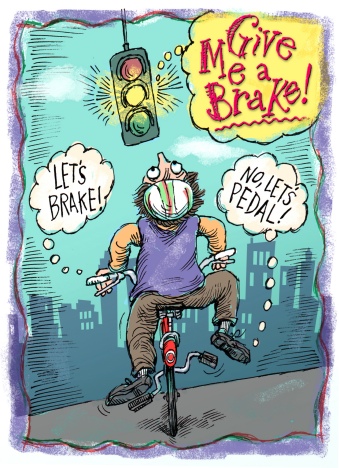
Here’s one answer. ORS 811.260 deals with, “Appropriate driver responses to traffic control devices.” In subsection 3, it states:
(3) Steady circular yellow signal. A driver facing a steady circular yellow signal light is thereby warned that the related right of way is being terminated and that a red or flashing red light will be shown immediately. A driver facing the light shall stop at a clearly marked stop line, but if none, shall stop before entering the marked crosswalk on the near side of the intersection, or if there is no marked crosswalk, then before entering the intersection. If a driver cannot stop in safety, the driver may drive cautiously through the intersection. (A “driver” as used in this statute is also considered a bicyclist. 811.400(1)(a))
The law is clear. Entering an intersection on a solid yellow light is illegal in Oregon unless you cannot stop in time safely. What “…stop in time safely” means depends on the officer’s opinion of whether or not you had the time to do so. This clause, “…cannot stop in time safely,” is not a get-out-of-jail-free card for failure to use the brakes. Rather, implicit in this statute is a driver’s ability and responsibility to control their vehicle’s speed so as to stop safely before entering an intersection on a solid yellow.
Are you willing to bet your life you’ll cross the entire intersection before the light goes red?
If you are traveling so quickly that stopping would send you over the handlebars, or the road is slick and you may prohibit your ability to stop safely before entering the intersection, you may qualify as the exception.
There is, of course, a larger consideration. Are you willing to bet your life you’ll cross the entire intersection before the light goes red? You should know that 33% of all bicycle and motor vehicle crashes happen in intersections.
You may be competing directly with a motor vehicle operator coming from behind who is as focused on the signal as you are and is hoping to make a right hand turn before it changes. Or there may be someone in the far right lane of the opposing traffic that sees the light is changing and may not be slowing down or looking at cross traffic.
If you still decide the risk is worth it, here’s one more thought. On average, the light will go from yellow to red on the 4th second. If you are traveling at 12mph and crossing 5 – 12 foot lanes or 60 feet of road, you are covering 17.6 feet a second. In the 3 seconds of yellow grace, you’ll cover 52.8 feet making it almost all the way across.
The choice is always situational and personal. As you near a stale green light, the pedestrian signals, if activated, do offer a good guideline for the possibility of crossing. As long as the walking figure appears or the red hand is flashing, your light will stay green. A pedestrian signal that counts down is even better, but once the hand goes to solid red, the traffic signal is about to change and should help inform your judgment. The goal is to avoid damage, crashes, injuries or fatalities.
As always, it’s up to you.



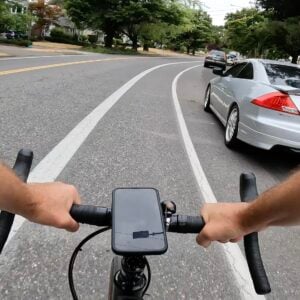
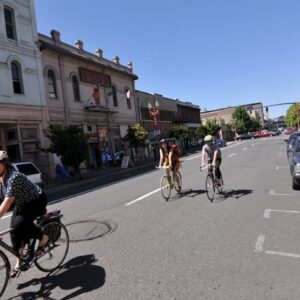
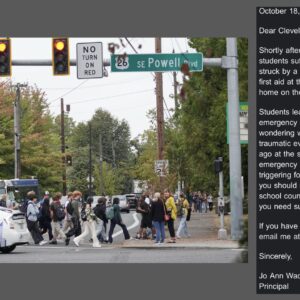
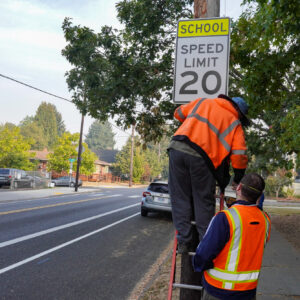
Thanks for reading.
BikePortland has served this community with independent community journalism since 2005. We rely on subscriptions from readers like you to survive. Your financial support is vital in keeping this valuable resource alive and well.
Please subscribe today to strengthen and expand our work.
We’re stopping at red lights now? 😛
I’m stopping at red lights, but I can’t vouch for the motorist behind me, so I’ll give a quick glance behind before stopping at a yellow.
This is one of those things that keeps me from wholeheartly saying: riding in traffic is easy. It’s kind of tricky, but pretty much everyone can do it…
I do enjoy the new counting down crosswalk signals – part challenge and part reality check.
Amen.
If 33% of all bicycle and motor vehicle crashes happen in intersections, then why should we stay out of the intersection where 67% off all bicycle and motor vehicle crashes happen?!?
😉
–Bill
All I know is that for me its the ‘guilt’ zone. As in I’m going to accelerate, and I might feel guilty about it
I saw a car run clean through a red light at a lighted crosswalk yesterday at se 39th and Lincoln. No matter if it’s a stop sign, or a light, you should always slow and look both ways before entering. The world is not a machine and people can do whatever the hell they want, including running red lights and stop signs. Do you want to become road pizza? Oh and wear a helmet you stupid hipsters… your dredds and jihad beards will not save you.
Lame.
Neither will your bike helmet.
wearing a helmet is a choice that rears little affect in your probability of getting hurt or not. riding safely and looking through all possible intersections and using your all the senses to detect the location of cars around you is equal if not higher priority then a false sense-of-protection in the form of helmets. attaching your abstract label to a group of people that take different safety measures than you says nothing constructive and simply exposes your judgmental assumptions in the brief seconds you pass an unhelmeted cyclist on the road.
now if you want to talk headphones, sure — take your **** headphones OFF.
In general, in these situations I choose to stop (and signal that intent) when it is not possible to clear the intersection before it turns red. My one request for my fellow cyclists who choose to accelerate and take their chances is that, if you do so, please do not scream at me as you blow by me from behind and please be paying enough attention so that you don’t run into my back tire. Both have happened more than once and neither is very pleasant.
One other comment- it would be a lot easier to know when there is going to be enough time if the delay between the flashing hand going to solid red to the light turning red was consistent from one light to the other. In some cases there is a solid red hand for barely an instant before the light changes, while at other intersections it is solid for what seems like close to 10 seconds.
with the exception of a very few signalized intersections, when the hand stops flashing or the countdown reaches zero is when the light turns yellow. Lengths of the yellow phase may vary from location to location.
I know of at least 8 where this is not true. Knott and 15th, 33rd for starters. Others i remember as I go through them. Albina and Alberta. There are others
To clarify for NE Knott & 15th: Traveling E/W there is a ~8 second delay between the steady hand and the yellow light. Traveling N/S there is a countdown on the crosswalk, when it hits zero, the light turns yellow.
I would be more inclined to say that the city is inconsistent with coordination of yellows and crosswalk signals. Even with new construction, such as the Burnside Couch couplet, the behavior is not consistent.
Personally, I would prefer consistency rather than having to memorize behavior at each intersection.
What if I stop because I expect the yellow, but the guy behind me doesn’t because he knows the yellow won’t hit for 4 more seconds?
I completely agree. Taking the historical knowledge out of the equation would be ideal. Perhaps the MUTCD should be updated to specify one configuration as legal and all others as illegal 🙂
Also there is the fairness aspect, why don’t pedestrians get the full use of the green phase? The law already prohibited them from having access during the amber phase. If there is that much time left than there should be more time allowed during the WALK or white man phase.
If people are behind you when you are stopping you should flash the “I”m stopping” hand signal it only takes a second and might save you, and others who are not aware of your impending stop from further collisions.
The pedestrian signals are often handy, but keep in mind that they’re designed and timed for — get this — pedestrians! Since every intersection is different, those crafty traffic engineers figure out the best signal timing to accommodate the various traffic movements as well as pedestrians at each individual intersection. Sometimes they want the pedestrians out of the intersection sooner (i.e. they want to ensure that pedestrians don’t get caught in the street when the light turns green), hence the lack of a direct correlation between the time when the red hand stops flashing and the yellow light appears. It’s not random, it’s a carefully thought-out orchestration of movements.
So remember — while the ped signal often provides additional information about the signal cycle, if you’re operating your bike as a vehicle on the road, rely first and foremost on the traffic signal.
Sorry, there are just too many poorly timed lights (ped, bike, car) in town for me to believe they’re all ” carefully thought-out orchestration”.
As an example of the “not thought very much about” category, drive down SE 11th from Burnside. The speed limit is 30. The lights are timed for a minimum of 33. Not so well planned.
As for ped signals, I find the count down buffer is excessively long in most new downtown locations.
However, in the new eastside couplet, there is just barely time to cross Sandy/12th at Burnside, often leaving peds stranded in the ‘refuge’. I can’t imagine crossing that intersection if I couldn’t move at a fast clip.
I hit a fellow cyclist in this situation once (I was driving my car). It was on the intersection of SE 12th and SE Hawthorne. I was heading Northbound on 12th and was in the far right lane. The line is slightly slanted so the cars in the left two lanes were also in front of me. To make matters worse, she was turning into Ladds Addition rather than going straight through up Hawthorne, which brought her right next to my bumper.
When I got a green light I started to go and hit the cyclist who was faced with the situation in this article. She decided to try to whiz through rather than stop. I felt awful about hitting her, but also frustrated that she was still in the intersection when I had a green light. She was obviously upset she was hit and felt that with a wet road it was safer to try to speed up and go through rather than brake.
I’d only gone forward about 6-18 inches before making contact with her and she was fortunately uninjured. We didn’t really know what to do at that point so we called 911 to try to get a squad car to the scene to report it. After waiting for 30 min we gave up and I gave her a ride to the bike shop of her choice.
Definitely a tricky situation. Now when I drive I try to remember to wait 5-6 seconds after the green before going… occasionally much to the annoyance of drivers behind me.
That sounds like an aweful situation.
You can not enter the intersection on a green until it is free and clear and you are able to safely pass through it and out of the other side.
I debated about posting this because I was sure someone was going to suggest it was a black and white situation and that it was all my fault. So thanks for that.
Riding through downtown, I find that even if I manage to squeak through a yellow light, I end up getting caught at a red at the next intersection.
the major north/south streets, at least, are timed to about 12 mph. so if you catch one and you are rolling at 12 plus, you will catch the others.
We’re fortunate in Boston to have countdown pedestrian timers on _most_ lights, which helps a lot. My concern at stopping for yellows is mostly getting rear-ended by a driver gunning for the “orange” light. when I’m in the lane I ALWAYS do a shoulder check to make sure I’m clear before I stop hard at a yellow.
This is the kind of thing that newbies don’t know to do though, and it is a real danger, so I’m glad you’re publicizing the issue
Another reason to love countdown pedestrian signals, though they aren’t always accurate.
One other issue are the lights that literally either never change without a car present or change back to red before you can even clip in.
Which is why we’ve done studies on signal timing at crosswalks (for peds, but bikes will be affected, too). Another example of what’s good for peds is good for bikes.
The countdown pedestrian signals are quite helpful for motorists as well as the pedestrians and cyclists. Sure, they’re not always aligned with a yellow light, but I look for the countdown to give me that extra bit of info on whether to “gun it” or lay off the gas, and stop.
As a cyclist, I’m always trying to pay attention far enough ahead of me to decide whether a “stale green” is worth racing through.